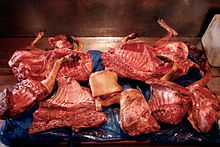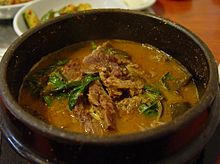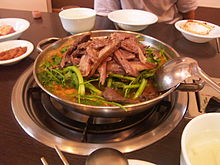- Dog meat consumption in South Korea
-
South Korean name Hangul 개고기 Revised Romanization Gaegogi McCune-Reischauer Kaegogi North Korean name Chosŏn'gŭl 단고기 McCune-Reischauer Tan'gogi Revised Romanization Dan(-)gogi The consumption of dog meat, called Gaegogi (개고기) in Korean, has had a long history in South Korea as well as other Eastern Asian cultures, but it has been controversial both inside and outside of the country due to animal rights and sanitary concerns.
Contents
History
The consumption of dog meat can be traced back to antiquity. Dog bones were excavated in a neolithic settlement in Changnyeong , Gyeongsangnam-do Province. A wall painting in the Goguryeo tombs complex in South Hwangghae Province, a UNESCO World Heritage site which dates from 4th century AD, depicts a slaughtered dog in a storehouse (Ahn, 2000).[1] The Balhae people also enjoyed dog meat, and the Koreans' appetite for canine cuisine seems to have come from that era.[2]
Koreans have distinguished Chinese terms for dog "견; 犬", which refers to pet dogs, feral dogs, and wolves from the chinese term "구; 狗," which is used specifically to indicate dog meat. "Hwangu" has been considered better for consumption than "Baekgu" (White dog) and "Heukgu" (Black dog).[3]
Approximately In 1816, Jeong Hak-yu (정학유; 丁學遊), the second son of Jeong Yak-yong , a prominent politician and scholar of Choseon dynasty at the time, wrote a poem called Nongawollyeonga. This poem, which is an important source of Korean folk history, describes what ordinary Korean farming families did in each month of a year. In the description of the month of August the poem tells of a married woman visiting her birth parents with boiled dog meat, rice cake, and rice wine, thus showing the popularity of dog meat at the time (Ahn, 2000; Seo, 2002). Dongguk Seshigi, a book written by a Korean scholar Hong Seok Mo in 1849, contains a recipe of Boshintang including a boiled dog, green onion, and red chili pepper powder.[1]
Current situation
The primary breed raised in dog farms for meat consumption, the Nureongi (누렁이), or Hwangu (황구; 黃狗), differs from those breeds raised for domestic pets.[4][5] Although a fair number of South Koreans (anywhere from 5 to 30%) have eaten dog meat at least once in their lifetime, only a small percentage of the population eats it regularly. There is a large and vocal group of Korean people that are against the practice of eating dog meat.[6] There is also a large population of people in South Korea that do not eat or enjoy the meat, but do feel strongly that it is the right of others to do so.[6] There is a smaller but still vocal group of pro-dog cuisine people in South Korea who want to popularize the consumption of dog in Korea and the rest of the world,[6] considering it to be part of the traditional culture of Korea with a long history worth preserving.
The BBC claims that in 2003, approximately 4,000-6,000 restaurants served soups made from dog meat in Korea.[7] The soups cost about US$10 while dishes of steamed dog meat with rice cost about US$25. The BBC claims that eighty-five hundred tons of dog meat are consumed per year, with another 93,600 tons used to produce a medicinal tonic called Gaesoju (개소주).[7]
Dog meat is often consumed during the summer months and is either roasted or prepared in soups or stews.[8] The most popular of these soups is Gaejang-guk, a spicy stew meant to balance the body's heat during the summer months. This is thought to ensure good health by balancing one's "ki" or vital energy of the body. A 19th century version of Gaejang-guk (개장국) explains the preparation of the dish by boiling dog meat with green onions and chili powder. Variations of the dish contain chicken and bamboo shoots.[9]
Types of dishes
See also: Korean cuisine- Bosintang (보신탕; 補身湯); Gaejangguk (개장국)) - Stew containing boiled dog meat and vegetables.[10]
- Gaegogi Jeongol (개고기 전골) - An elaborate dog stew made in a large Jeongol pan.
- Gae Suyuk (개 수육; 개水肉)- Boiled dog meat [10]
- Gaegogi Muchim (개고기 무침) - Steamed dog meat, Korean leeks (부추), and vegetables mixed with spices [10]
- Gaesoju (개소주; 개燒酒) - Mixed drink containing dog meat and other Chinese medicine ingredients such as ginger, chestnut, and jujube to invigorate one's health [7][11]
Controversy
Use of dogs for meat and the methods of slaughter used have generated friction between dog lovers, both Westerners and Koreans, and people who eat dogs; the conflict occasionally breaks out as headline news. During the 1988 Summer Olympics in Seoul, the South Korean government urged its citizens not to consume dog meat in order to avoid bad publicity during the games, along with a request to butcher shops not to hang dog carcasses in the windows.[12] It also closed all restaurants serving Gaejang-guk to better improve the country's image to Western visitors.
The controversy surfaced again in 2001 during the 2002 FIFA World Cup.[13][14] The organizers of the games, under pressure from animal rights groups such as PETA. demanded that the Korean government re-address the issue. Brigitte Bardot, a prominent head of a French animal rights organization which is named after her, launched a crusade during the 2002 FIFA World Cup to have dog meat outlawed in Korea. She prompted people to boycott the games if the government did not outlaw the sale of dog meat in restaurants in Seoul. This movement seemed unfair and out of place to many Koreans, as Bardot's organization has not accomplished anything about dog meat consumption in People's Republic of China, a country with much more political and financial influences on France and EU than South Korea, during 2008 Summer Olympics in Beijing, China, where dog meat (狗肉) has been seen as an affordable meat source and the records of dog consumption date back to 500 B.C. [15]
In Korea, some people eat Bosintang (literally "invigorating soup"), believing it to have medicinal properties, particularly as relates to virility. Dog meat is also believed to keep one cool during the intense Korean summer. Many Korean Buddhists consider eating meat an offense, which includes dog meat.[16] Unlike beef, pork, or poultry, dog meat has no legal status as food in South Korea. Hence dog meat farming takes place in a legal grey area.[17] Some in South Korea and abroad believe that dog meat should be expressly legalized so that only authorized preparers can deal with the meat in more humane and sanitary ways, while others think that the practice should be banned by law.
In recent years, many Korean people have changed their attitudes towards eating dog meat from "personal choice" to "unnecessary cruelty." Animal rights activists in South Korea protest against the custom of eating dog meat.[18] A recent survey by the Korean Ministry of Agriculture showed that 59% of Koreans aged under 30 would not eat dog. Some 62% of the same age group said they regard dogs as pets, not food.[17] Many young Koreans think those who eat dog are an anachronism.[17] Although early Western media reports stated that some dogs were beaten to death,[19] the dogs are not butchered in that way these days [10][17] and usually instantly killed by a blow with an electric rod.[10]
See also
Notes
- ^ a b [1] 2008 Seoul Shinmoon article
- ^ A Study of the favorite Foods of the Balhae People Yang Ouk-da
- ^ S. Huh. (2004, p.83). 비주, 숨겨진 우리 술을 찾아서 [Rediscovering Korean liquors]. Pajoo, Korea: Woongjin Thinkbig. ISBN 8901047209
- ^ *Podberscek, Anthony L. (2009). "Good to Pet and Eat: The Keeping and Consuming of Dogs and Cats in South Korea". Journal of Social Issues 65 (3): 615–632. doi:10.1111/j.1540-4560.2009.01616.x. http://www.animalsandsociety.org/assets/265_podberscek.pdf.
- ^ Delicious yet sometimes peculiar Korean cuisine 23 April 2009, Helsinki Times
- ^ a b c Do Koreans Really Eat Dog? about.com
- ^ a b c South Korea's dog day, BBC News, 17 August 1999.
- ^ Kim, Tae-Yi, Reuters, "Dog on the menu in Korea to beat the heat", Yahoo! News, 14 July 2011; retrieved 15 July 2011.
- ^ Pettid, Michael J., Korean Cuisine: An Illustrated History, London: Reaktion Books Ltd., 2008, 84-85.
- ^ a b c d e 2004 Seoul Shinmoon article
- ^ [2] Doosan Cyclopedia
- ^ Derr, Mark (2004). Dog's Best Friend. Chicago: University of Chicago Press. pp. 26–27. ISBN 0226142809.
- ^ "Fifa warns S Korea over dog meat". BBC News Asia-Pacific. 2001-11-06. http://news.bbc.co.uk/2/hi/asia-pacific/1640848.stm. Retrieved 2006-12-01.
- ^ "S Korea dog meat row deepens". BBC News Asia-Pacific. 2001-11-12. http://news.bbc.co.uk/2/hi/asia-pacific/1651543.stm. Retrieved 2006-12-01.
- ^ [3]
- ^ 마성 (6 October 2004). "불교는 육식을 금하는 종교인가 [Is Buddhism a Religion that Restricts Meat Eating?]" (in Korean). The Buddhist Review (Seoul, Korea). http://www.budreview.com/news/articleView.html?idxno=469. Retrieved 16 October 2010. "현재 한국의 사찰에서는 관습적으로 육식을 금하고 있기 때문이다."
- ^ a b c d Young Koreans turn their noses up at dog dinners By Daniel Jeffreys in Seoul,3 August 2007, independent.co.uk
- ^ Activists protest against dog meat eating, BBC[4]
- ^ Associated Press (January 11, 2002). "Korean Group Creates Dogmeat Association". Fox News. http://www.foxnews.com/story/0,2933,42748,00.html. Retrieved 2009-06-11.
References
- Ahn, Y. (2000). 한국인과 개고기 [Koreans and dog meat]. Seoul: Hyoil. (ISBN 8985768964)
- Seo, J. (2002). 한국무속인열전 1 [Korean Shamans I]. Seoul: Woosuk Publishing. (ISBN 8936104314)
Further reading
- Kim, Rakhyun E. (2008). "Dog Meat in Korea: A Socio-Legal Challenge". Animal Law 14 (2): 201–236. SSRN 1325574.
- Yong-Geun Ann, Ph.D (in Korean and English). Dog Meat. Hyoil Book Publishing Company. http://wolf.ok.ac.kr/~annyg/english/. (contains some recipes)
External links
- Do Koreans Really Eat Dog? About.com
Categories:- South Korean cuisine
- Meat
Wikimedia Foundation. 2010.



